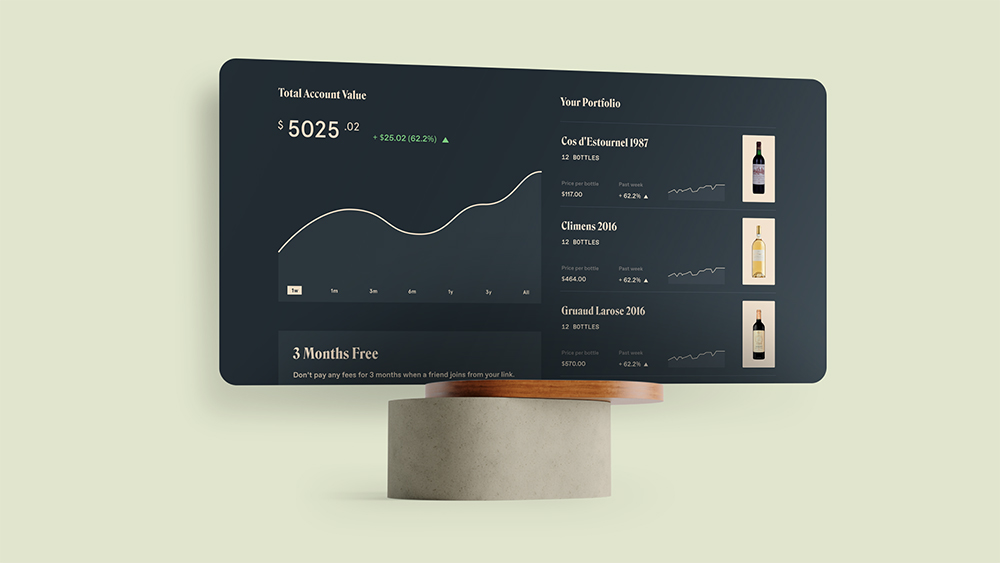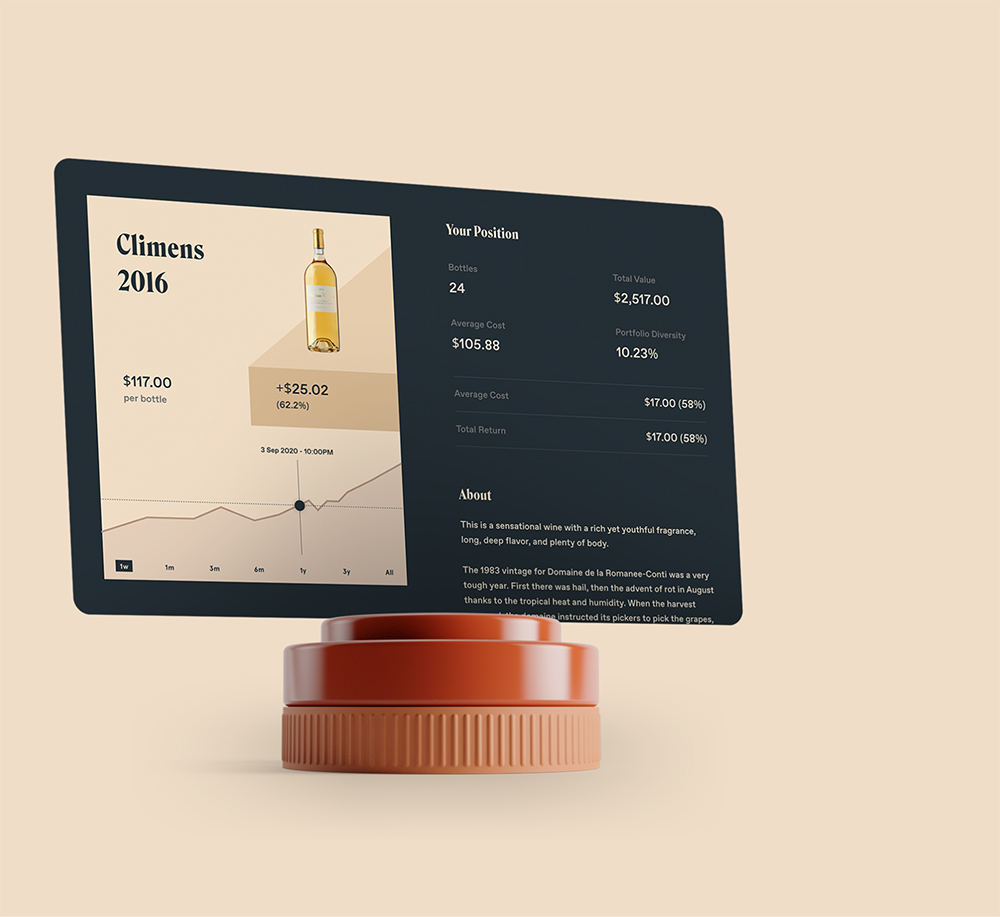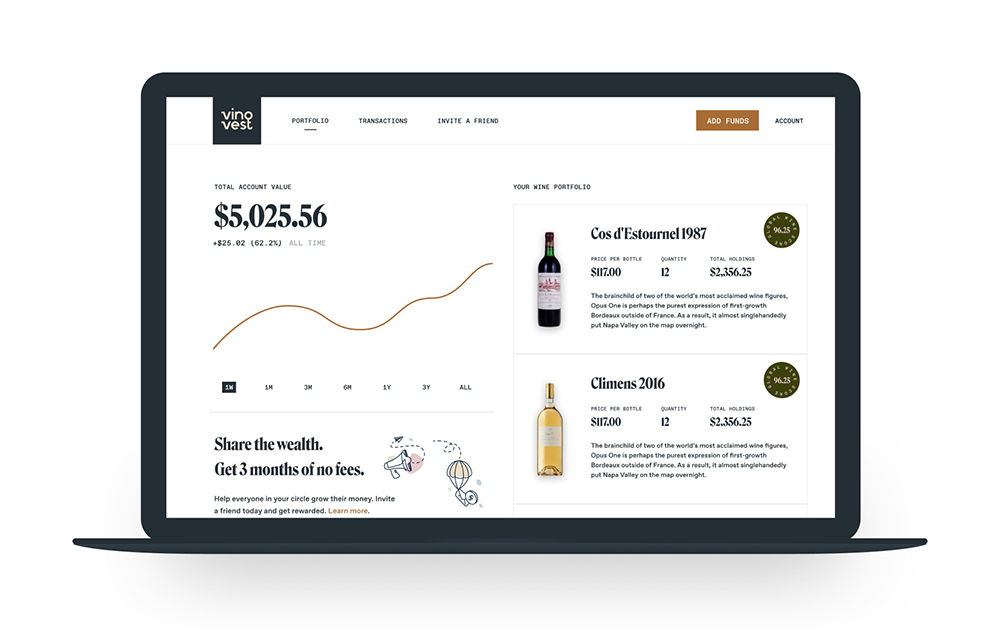有了这款APP,红酒投资不再是小众专宠

在大多数人看来,投资葡萄酒似乎只是少数富豪的专属,是一种比较封闭的小众爱好。很多名酒拍卖会都是在苏富比(Sotheby’s)、Acker Merrall& Condit(AMC)和施氏佳酿(Zachys)等知名拍卖行举行的,竞拍者都是全球前1%的富人。在这种拍卖会上,一瓶于泽干邑动辄能够拍出5.1万美元的高价,让不少想进入品酒圈的新人咂舌不已。另外,挑酒也是一门水很深的艺术,有的红酒存放的年头越长,价格越高,比如大名鼎鼎的拉菲酒庄(Château Lafite Rothschild)和罗曼尼康帝酒庄(Domaine de la Romanée-Conti)的酒。如果你不提前好几年预约,再交上几万美元的学费,这种真正具有投资价值的名酒,你基本上是一瓶也拿不到手的。
但是随着最新科技平台Vinovest的上线,现在所有人都从事红酒投资了。
Vinovest的联合创始人安东尼·张20多岁时就卖掉了自己在旧金山创办的第一家公司,手里有了一些可以投资的积蓄。安东尼·张本人是一名葡萄酒爱好者,于是他开始寻找这个行业的投资机会,但始终不得其门而入——他发现自己既没有雄厚的财力,也不认识那些低调的名酒掮客,跟那些多年的老藏家完全不在一条起跑线上。另外,他也无法获得名酒拍卖会的入场券,更接触不到那些藏家们趋之若鹜的酒庄。而只有这些酒庄的酒,才具备巨大的投资价值。
但他发现,自己能够找到近几十年来关于葡萄酒价格的大量公开数据。作为一位聪明的程序员,他立即编写了一个算法,来预测哪些葡萄酒最有升值空间。五年之后,这个算法变成了现在的Vinovest,它可以代表用户,通过机器学习技术,从业内的顶级酒庄收购和销售葡萄酒。安东尼·张已经成立了一支11人的葡萄酒经纪、采购、存储、保险和管理团队。投资者也发现了红酒投资的利润。2020年,Vinovest的年化回报率中值超过了17%。
安东尼·张说:“酒是越陈越好,同时也是越陈越少,从而带来了投资机会,因为它的价格会随着时间而上涨。不过从事和参与葡萄酒投资,却是一项很难让人摸到头绪而且价格不菲的活动。当时在我看来,葡萄酒投资只适合那些已经很富有的人,这让我感到很不舒服。”

名酒的收藏与投资并非什么新鲜事物,但它的高门槛确实令很多潜在投资者望而却步,即便是红酒行业的从业者也不敢轻易入坑。一般情况下,投资者会通过佳士得(Christie’s)等老牌拍卖公司寻找值得投资的葡萄酒,或者从私人藏家手中购买。另外还能够购买葡萄酒“期货”,也就是预售权,比如波尔多、勃艮第和纳帕谷等地的知名酒庄都会提前开展预售。投资者也可以通过红酒经纪商来打理与热门酒庄的关系,或者通过他们在拍卖会上锁定合适的拍品。拍下的红酒会被送到由客户个人管理的仓库储存起来,直到他们将这批红酒再次出手。名酒的销售也是一件很严肃的事情,所有待销红酒都需要经过专家的真品鉴定,以确认其原产地,然后才有资格上拍卖会。
这一套流程下来,既需要大量时间,也需要不菲的资金,通常至少要几万美元打底。要想通过投资名酒赚钱,投资者不仅要有金融领域的知识,还要能够分析和预测10年、20年、30年甚至更长时间的价格走势。安东尼·张起初将红酒投资当作一项个人爱好,所以他并没有留意自己在数据收集和构建初始模型上花费了多少时间,但他绝对为此付出了大量的心血。
Vinovest公司的顾问、品酒师乔纳森·罗斯指出:“对于不经常接触葡萄酒,或者没有亲自购买和品尝过足够葡萄酒的人来说,红酒拍卖的‘水’是很深的。”罗斯解释道,普通人在拍卖公司开户的时候,是没有人指导他们的,他只能够依赖以往的品酒和购酒经验,但这和酒的升值空间未必挂钩。“你必须知道哪些酒最适合长期陈放,哪个产地的哪块葡萄园才可以酿出最有升值空间的酒。另外还有酒庄的生产质量和声誉的问题,这里还有很多主观因素和灰色地带。”
而Vinovest的技术则抹掉了这些灰色地带。安东尼·张的算法分析了各种红酒在不同时间跨度内的升值空间、各种酒的饮用窗口(即最佳陈放时间)、各种因素与拍卖价格的相关性、评论家的评分、各种酒的技术分析指标,以及所有可能影响红酒价格的其他细节因素,以预判投资一瓶酒什么时候能够盈利。
“这样一来,在做投资决策时,大家就没有必要再做很多金融分析了。”安东尼·张说。他也认为,红酒投资里存在很多主观因素。“我想通过做这样一个软件,采取一种更定量的分析方法,来帮助那些对葡萄酒知少甚少的人。”
那么,Vinovest是怎样帮到投资者的呢?很简单,用户可以先告诉Vinovest自己有多少钱能够投资,以及自己计划的投资年限。用户本人甚至不必具备任何葡萄酒的专业知识。然后Vinovest会向投资者推荐合适的葡萄酒产区和酒的类型,然后帮助用户完成从购酒、存酒到保险和管理的全套手续,当然Vinovest也会收取少量手续费。如果你的投资级别较高,就有机会入手更珍稀的名酒。Vinovest和别的股票管理平台大同小异,只不过它的产品有形的,而并非一串电子数据。

买来的酒去了哪儿呢?多数时候,它都会待在仓库里。安东尼·张已经建立了一个全球的储存设施网络。这样一来就省去了运输成本,也免去了红酒跨国运输的高额关税和其他税费,这也就给投资者省了钱。
罗斯指出,Vinovest是做红酒投资的,不是做红酒收藏的,所以用户不要指望把收购的红酒摆在家里,甚至是拿来自己喝,那是收藏家才会干的事情。葡萄酒投资的重点,不在于你喜欢或者不喜欢什么,而在于远期的回报。毕竟一瓶酒一旦喝下了肚,就再没有什么投资回报可言了。
安东尼·张称,各大酒庄都很乐于与他合作,而他也更喜欢从酒庄和经销商那里直接购酒,而不是通过拍卖行,因为只有源头采购才更放心,同时红酒在存储、运输和保真等方面出问题的机率也更小。各大酒庄青睐Vinovest还有另一个原因,那就是它带来了很多新的投资者,而且其中大都是年轻人——安东尼·张主要瞄准25岁到40岁的投资者,因此他将最低投资额度限定在1000美元,而且他在Instagram上也投放了广告。他知道自己吸引不了那些平时只喝15美元一瓶的廉价红酒的人,但他有可能吸引到那些想在股市之外寻找高回报投资机会的人,而这些人恰巧也对高档西餐厅里的红酒感兴趣。
“为什么只有已经进入了这个小圈子的人,才知道投资红酒有这么高的回报呢?”他说:“有了这个平台,任何人都能够投资红酒,不管他们住在哪里,也不管他们来自什么背景。从这里开始,大家可以很容易地了解到红酒的投资类型。”(财富中文网)
译者:朴成奎
在大多数人看来,投资葡萄酒似乎只是少数富豪的专属,是一种比较封闭的小众爱好。很多名酒拍卖会都是在苏富比(Sotheby’s)、Acker Merrall& Condit(AMC)和施氏佳酿(Zachys)等知名拍卖行举行的,竞拍者都是全球前1%的富人。在这种拍卖会上,一瓶于泽干邑动辄能够拍出5.1万美元的高价,让不少想进入品酒圈的新人咂舌不已。另外,挑酒也是一门水很深的艺术,有的红酒存放的年头越长,价格越高,比如大名鼎鼎的拉菲酒庄(Château Lafite Rothschild)和罗曼尼康帝酒庄(Domaine de la Romanée-Conti)的酒。如果你不提前好几年预约,再交上几万美元的学费,这种真正具有投资价值的名酒,你基本上是一瓶也拿不到手的。
但是随着最新科技平台Vinovest的上线,现在所有人都从事红酒投资了。
Vinovest的联合创始人安东尼·张20多岁时就卖掉了自己在旧金山创办的第一家公司,手里有了一些可以投资的积蓄。安东尼·张本人是一名葡萄酒爱好者,于是他开始寻找这个行业的投资机会,但始终不得其门而入——他发现自己既没有雄厚的财力,也不认识那些低调的名酒掮客,跟那些多年的老藏家完全不在一条起跑线上。另外,他也无法获得名酒拍卖会的入场券,更接触不到那些藏家们趋之若鹜的酒庄。而只有这些酒庄的酒,才具备巨大的投资价值。
但他发现,自己能够找到近几十年来关于葡萄酒价格的大量公开数据。作为一位聪明的程序员,他立即编写了一个算法,来预测哪些葡萄酒最有升值空间。五年之后,这个算法变成了现在的Vinovest,它可以代表用户,通过机器学习技术,从业内的顶级酒庄收购和销售葡萄酒。安东尼·张已经成立了一支11人的葡萄酒经纪、采购、存储、保险和管理团队。投资者也发现了红酒投资的利润。2020年,Vinovest的年化回报率中值超过了17%。
安东尼·张说:“酒是越陈越好,同时也是越陈越少,从而带来了投资机会,因为它的价格会随着时间而上涨。不过从事和参与葡萄酒投资,却是一项很难让人摸到头绪而且价格不菲的活动。当时在我看来,葡萄酒投资只适合那些已经很富有的人,这让我感到很不舒服。”
名酒的收藏与投资并非什么新鲜事物,但它的高门槛确实令很多潜在投资者望而却步,即便是红酒行业的从业者也不敢轻易入坑。一般情况下,投资者会通过佳士得(Christie’s)等老牌拍卖公司寻找值得投资的葡萄酒,或者从私人藏家手中购买。另外还能够购买葡萄酒“期货”,也就是预售权,比如波尔多、勃艮第和纳帕谷等地的知名酒庄都会提前开展预售。投资者也可以通过红酒经纪商来打理与热门酒庄的关系,或者通过他们在拍卖会上锁定合适的拍品。拍下的红酒会被送到由客户个人管理的仓库储存起来,直到他们将这批红酒再次出手。名酒的销售也是一件很严肃的事情,所有待销红酒都需要经过专家的真品鉴定,以确认其原产地,然后才有资格上拍卖会。
这一套流程下来,既需要大量时间,也需要不菲的资金,通常至少要几万美元打底。要想通过投资名酒赚钱,投资者不仅要有金融领域的知识,还要能够分析和预测10年、20年、30年甚至更长时间的价格走势。安东尼·张起初将红酒投资当作一项个人爱好,所以他并没有留意自己在数据收集和构建初始模型上花费了多少时间,但他绝对为此付出了大量的心血。
Vinovest公司的顾问、品酒师乔纳森·罗斯指出:“对于不经常接触葡萄酒,或者没有亲自购买和品尝过足够葡萄酒的人来说,红酒拍卖的‘水’是很深的。”罗斯解释道,普通人在拍卖公司开户的时候,是没有人指导他们的,他只能够依赖以往的品酒和购酒经验,但这和酒的升值空间未必挂钩。“你必须知道哪些酒最适合长期陈放,哪个产地的哪块葡萄园才可以酿出最有升值空间的酒。另外还有酒庄的生产质量和声誉的问题,这里还有很多主观因素和灰色地带。”
而Vinovest的技术则抹掉了这些灰色地带。安东尼·张的算法分析了各种红酒在不同时间跨度内的升值空间、各种酒的饮用窗口(即最佳陈放时间)、各种因素与拍卖价格的相关性、评论家的评分、各种酒的技术分析指标,以及所有可能影响红酒价格的其他细节因素,以预判投资一瓶酒什么时候能够盈利。
“这样一来,在做投资决策时,大家就没有必要再做很多金融分析了。”安东尼·张说。他也认为,红酒投资里存在很多主观因素。“我想通过做这样一个软件,采取一种更定量的分析方法,来帮助那些对葡萄酒知少甚少的人。”
那么,Vinovest是怎样帮到投资者的呢?很简单,用户可以先告诉Vinovest自己有多少钱能够投资,以及自己计划的投资年限。用户本人甚至不必具备任何葡萄酒的专业知识。然后Vinovest会向投资者推荐合适的葡萄酒产区和酒的类型,然后帮助用户完成从购酒、存酒到保险和管理的全套手续,当然Vinovest也会收取少量手续费。如果你的投资级别较高,就有机会入手更珍稀的名酒。Vinovest和别的股票管理平台大同小异,只不过它的产品有形的,而并非一串电子数据。
买来的酒去了哪儿呢?多数时候,它都会待在仓库里。安东尼·张已经建立了一个全球的储存设施网络。这样一来就省去了运输成本,也免去了红酒跨国运输的高额关税和其他税费,这也就给投资者省了钱。
罗斯指出,Vinovest是做红酒投资的,不是做红酒收藏的,所以用户不要指望把收购的红酒摆在家里,甚至是拿来自己喝,那是收藏家才会干的事情。葡萄酒投资的重点,不在于你喜欢或者不喜欢什么,而在于远期的回报。毕竟一瓶酒一旦喝下了肚,就再没有什么投资回报可言了。
安东尼·张称,各大酒庄都很乐于与他合作,而他也更喜欢从酒庄和经销商那里直接购酒,而不是通过拍卖行,因为只有源头采购才更放心,同时红酒在存储、运输和保真等方面出问题的机率也更小。各大酒庄青睐Vinovest还有另一个原因,那就是它带来了很多新的投资者,而且其中大都是年轻人——安东尼·张主要瞄准25岁到40岁的投资者,因此他将最低投资额度限定在1000美元,而且他在Instagram上也投放了广告。他知道自己吸引不了那些平时只喝15美元一瓶的廉价红酒的人,但他有可能吸引到那些想在股市之外寻找高回报投资机会的人,而这些人恰巧也对高档西餐厅里的红酒感兴趣。
“为什么只有已经进入了这个小圈子的人,才知道投资红酒有这么高的回报呢?”他说:“有了这个平台,任何人都能够投资红酒,不管他们住在哪里,也不管他们来自什么背景。从这里开始,大家可以很容易地了解到红酒的投资类型。”(财富中文网)
译者:朴成奎
Investing in blue-chip wines seems, to most, like an activity for a closed club of wealthy collectors. Many fine wine auctions are held at well-known houses like Sotheby’s, Acker Merrall& Condit, and Zachys that seem geared for the world’s one percent—places where Jay-Z auctions off a $52,000 bottle of D’Ussé cognac. It’s the type of atmosphere that feels intimidating to someone who is newer to the game. The same goes for snagging cases, or even a single bottle, of the most expensive wines in the world, like Château Lafite Rothschild and Domaine de la Romanée-Conti, which gain immense value over time. Without spending years on the waiting list for an allocation, and snapping up tens of thousands of dollars in other wine from gatekeepers, you don’t have much hope of acquiring any for yourself.
But that’s changing with technology platform Vinovest, which allows anyone and everyone to invest in fine and rare wine.
When Vinovest cofounder Anthony Zhang was in his early twenties, he found himself looking for a great place to invest some extra savings he had on hand after selling his first startup in San Francisco. Being a fan of wine, he started researching opportunities in the industry. He quickly felt shut out: He wasn’t a longtime collector with deep pockets and connections to secretive brokers; he couldn’t get invitations to exclusive wine auctions; and he didn’t have access to allocations from some of the most sought-after producers, whose wines fetch large returns on investment.
What he could find: a massive amount of public data on wine prices over the course of decades. Like any savvy programmer, he wrote an algorithm to predict which bottles would be the best to seek out. Five years later, that strategy has become Vinovest, which uses machine-learning technology to acquire and sell bottles from top producers on behalf of its users. Zhang’s team of 11 handles the brokers, buying, storage, insurance, and management. Investors see profits. The annualized median returns in 2020 were more than 17%.
“Wine gets better with age but also scarcer, which makes it an investment because the price will increase with time,” Zhang says. “Getting access and being able to participate, though, was confusing and expensive. It seemed to me that wine investing was only something for people who were already wealthy. That didn’t sit well with me.”
The wine asset class is nothing new, but, as Zhang says, access to the space has proved daunting for potential investors, even those who already work in the wine industry. Traditionally, wine investors look for bottles at auctions hosted by heritage companies like Christie’s; estate sales of private collectors; or through futures, which are essentially presales, of major wines like those from Bordeaux, Burgundy, and Napa Valley. Brokers work with investors to help them manage relationships with in-demand producers and find the right lots to bid on at auctions they may attend. Any acquired wines are then shipped to storage managed by the individual until he or she wants to resell the products in future. To sell is an undertaking in and of itself, one that involves steps like approvals from authenticity specialists to confirm provenance before an auction house will accept cases of wine to be sold.
To run the entire process takes a significant amount of time and access to capital, typically tens of thousands of dollars. To be successful, it takes financial knowledge and prediction analysis of what may sell in 10, 20, 30 years—or more. Zhang considered his wine investing project to be a hobby at first, so he didn’t track how many hours he spent gathering data for his original financial model. But it was a lot.
“Auctions and the like are tough to navigate for anyone that does not work with that caliber of wine on a regular basis, or has bought and drank enough wine to figure it out for themselves,” says Jonathan Ross, a master sommelier and adviser to Vinovest. Ross explains that when an individual signs up for an account at traditional auction houses, there is no one to guide them. One must rely on acquired wine experience, and that’s not necessarily related to financial performance. “It has always been based on knowing what vintage is best suited for long-term aging, and from which parcel of vines within a small, esoteric, delimited vineyard,” he adds. “And that doesn’t even scratch the surface of producer quality and reputation. There’s a lot of subjectivity and gray areas there.”
Vinovest’s technology takes away the gray areas. Zhang built an algorithm based on which wines would gain value over a variety of different timelines, using data around drinking windows (the optimal time to age a wine), how that historically relates to sales at auctions, critics’ scores, technical analysis indicators, and any other details that could affect price. All of this predicts when a specific wine can turn a profit.
“People aren’t necessarily doing a lot of financial analysis into those decisions,” Zhang says, echoing Ross’s sentiment about the subjectivity of investing in wine. “I wanted to take a more quantitative approach to see if I could make a case for using software, as someone who knew little about the wine world.”
How that helps an investor is simple. Users give Vinovest information on how much they want to invest and when they expect to see a return. They don’t even have to know anything about wine. The program recommends what region and type of wine that investor’s portfolio will focus on, then handles the acquisition, storage, insurance, and management for a small fee. Different levels of investment allow access to rarer or more exclusive wines. It’s like any other stock management platform, except that the product is tangible rather than electronic.
Where does that wine go? In most cases, it doesn’t leave its warehouse. Zhang built out a network of storage facilities around the globe. That eliminates shipping costs as well as hefty taxes and tariffs on transporting alcohol across country lines. That savings is passed along to the investor.
Ross is quick to point out that Vinovest is about wine investing, not collecting, so users shouldn’t expect to ever physically hold a bottle. A collector may want the wine within arm’s reach, so that he or she can pop it open for dinner. With wine investing, it’s less about what you like and don’t like, and more about what will see a return in the future. After all, it would be detrimental to one’s return on investment to drink the wine he or she has purchased, he adds.
Zhang says that producers are excited to work with him. He decided to work directly with wineries and distributors versus auction houses, since he felt more confident buying bottles for investment from the source. There would be less chance of variation in a wine’s storage, transport, and authenticity. What he’s found is that they appreciate his goal of providing access to a new set of investors, primarily younger ones: Zhang targets the 25- to 40-year-old market by placing the minimum investment at $1,000 and even running ads on Instagram. He knows he won’t be converting the person who drinks $15 bottles from the grocery store, but he might grab someone who is seeking a new lucrative asset class outside of stocks, and who also happens to enjoy perusing the wine list at an upscale restaurant.
“Why should the only people with a chance to see such high returns be the ones who are already in the room?” he says. “With this platform, anyone could do it, regardless of where they live or what their background is. It’s an easy starting point where one can learn about the investment type of wine.”













